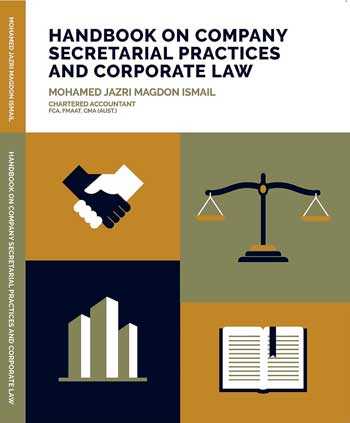Monday Dec 08, 2025
Monday Dec 08, 2025
Thursday, 17 October 2019 01:36 - - {{hitsCtrl.values.hits}}
By Tishan Subasinghe
I recently had the opportunity of reading an interesting book on secretarial practices and company law. I managed to read the book at a stretch mainly because of the simplicity of Jazri’s writing. Non-technical simple language is used in compiling the book. Though the book is titled as handbook on company secretarial practices and corporate law, I felt it would be much more useful for directors of corporate boards as a handbook on company law and other related areas. My book review is also done in the above context. 
The author
Jazri is a fellow Chartered Accountant by profession. He is also a member of Certified Management Accountants of Australia and a fellow member of AAT Sri Lanka. He is the President of the Association of Accounting Technicians (AAT). He has extensive experience as a member of senior management of reputed companies and later on as a member of the boards. The author carries reputation for his excellent oratory skills and his ability to put things in a simple yet convincing manner.
Case for authoring the book
It is my observation that most of the individuals who get invitations to join the boards accept such invitations without fully realising the risks and legal implications arising out of it. Risks would come in a much more handy manner with respect to corporates where there is a stake owned by the State. I have noted in so many occasions that the board of directors becomes aware of their obligations and liabilities once they have to face legal issues. Directors would be held liable for offences and non-compliances with respect to certain statutes. However it is important for any director to have at least a fair understanding about important provisions of the Companies Act No. 07 of 2007 as well as corporate governance best practices. Some of the offences as per the Companies Act are on issue of shares, company name, articles, of association, management and administration of the company, annual returns, meeting and proceedings, minutes and other records, annual reports, appointment of auditors, winding up, etc.
Jazri has covered almost all areas in a simple and concise manner. Most importantly he has blended his experiences gained as a Chartered Accountant and by serving on boards in different companies. What prompted the author to write this book is quoted below from the preface to the book: “It is a product of various clarifications I required in executing my role as director in different capacities in different companies. It is meant to be brief and does not claim to the exhaustive”.
However it is a quick guide for any of the use of matters that could arise during serious course of discussion at the board level. The book is forwarded by President’s Counsel Harsha Amarasekara and he commends the author for bringing a wealth of practical experience into his writing. In his message, KPMG Managing Partner Reyaz Mihular commends the author for avoiding the tendency to slip into legal jargon when dealing with some of the complex issues. 
The fish rots from the head
Before going to nitty-gritty of the companies act, the author has shared some of his initial thoughts under the following four headlines:
At the beginning the author has briefly given some corporate governance best practices, in terms of characteristics of a good board. However it is not an exhaustive list but an insight.
Then, the author has quoted from a speech delivered at London School of Economics (LSE) by Queen Elizabeth on the global financial crisis in 2008. The Queen has asked scholars of the LSE: “Why did no one notice the crisis on its way?” The author has deliberated this in terms of best practices to avoid financial crisis of a company from a board’s perspective.
The author has stressed the importance of ‘Tone at the Top’ in setting the culture of a corporate. He has emphasised the importance by giving reference to the Chinese proverb, ‘The fish rots from the head’. I think the proverb clearly gives the message to the Tone at the Top.
Guidance for prospective board members
There is a section that would be useful for professionals, who are aspiring to be board members. If I put it in other words, some career guidance for prospective board members. The author has structured the contents in 46 chapters supported with four annexures. Most of the chapters cover the salient section of the companies act.
However, there are certain chapters where the author has gone beyond the companies act and given useful information. Chapter 31 contains information on the structure and content of a good annual report. The author has exposed the reader to new annual reporting conventions such as sustainability and integrated reporting.
Chapter 37 is also of practical importance since it carries specimens of terms of references for audit committees and related party transaction review committees.
I’m also particularly attracted to the chapter where the director and board collective self-evaluation formats are given.
Later part of the book gives an insight to Colombo Stock Exchange (CSE) related reporting and other requirements.
This chapter would be useful for those who are making plans to list shares on the CSE in future appendices consisting model articles of association, a checklist on statutory forms and returns, specimen of prescribed important forms and guidance on incorporating a company limited by guarantee.
Conclusion
Overall the book would be useful for company secretaries and board members. The book in fact can be used as a handbook for board directors because of its simplicity and absence of technical jargon.
The author has well-presented the book and I’m looking forward to reading his second book soon.
I purchased this book for Rs. 1,500 at the Association of Accounting Technicians of Sri Lanka, Colombo 5. The net proceeds of this book are donated to an Orphan Care Trust – a charitable institution.
(The writer Tishan Subasinghe is Managing Director at Moore Stephens Consulting Ltd.)